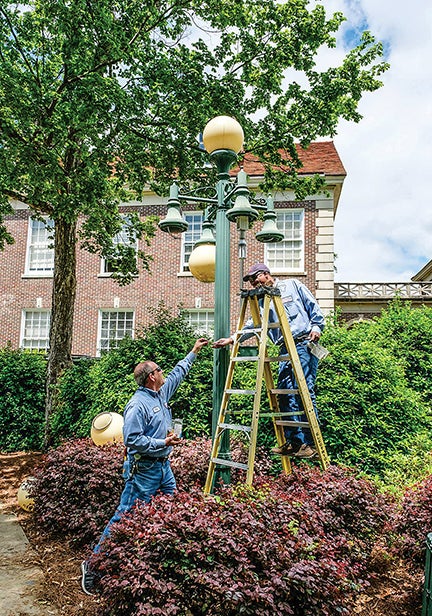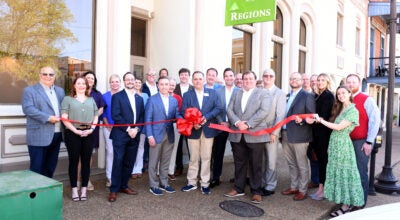Ole Miss partnership with TVA, NEMEPA saves $217,000 annually
Published 2:00 am Sunday, May 7, 2017

- Robert Jordan/Ole Miss Communications Ole Miss Facilities Management staff upgrade one of the lamppost on campus to LED lights.
By Michael Newsom
University of Mississippi
The University of Mississippi, Tennessee Valley Authority and North East Mississippi Electric Power Association marked the completion Thursday of a project that saves the university more than $217,000 in utility costs each year and reduces its carbon footprint.
The TVA awarded the university a $150,00 grant to improve energy efficiency on campus by installing LED lightning, which lasts about 11 years and is more energy efficient than other bulbs, as well as make other retrofits.
The university also created an Energy Committee, which developed a plan for responsible management of power resources with a holistic approach that integrates the school’s core mission moving forward.
“We must be good stewards of our resources and committed to sustainability,” UM Chancellor Jeffrey S. Vitter said. “This investment by TVA assists with our efforts and has helped us identify and make key energy improvements across campus, maximize resources and reduce overall energy consumption.”
University leaders gathered Thursday with representatives from TVA and NEMEPA to mark the completion of the project, which will save 2.7 million kilowatt hours per year. In electricity use terms, that’s the equivalent of 200 homes’ total energy consumption for a year.
The work also creates a carbon output reduction equal to taking 401 cars off the road each year.
It’s expected the investment in the project will pay for itself in just over two-and-a-half years, based on the savings calculation of $217,000 annually.
TVA has given $450,000 to Ole Miss, Mississippi State University and Mississippi University for Women as part of this grant program, and more than $1 million collectively with other TVA EnergyRight Solutions programs.
TVA is proud of the strong partnership it has with the university, said David Sparks, TVA’s Mississippi energy utilization and marketing manager.
“The University of Mississippi successfully utilized this award to identify and make key energy improvements across campus, helping maximize resources and reduce overall energy consumption,” Sparks said. “The savings from this program and the partnership will help TVA fulfill its commitment to a lower carbon future.”
About 55 percent of TVA’s energy mix is carbon-free, as a result of sustainability partnerships and projects. In 2016, TVA projects saved enough power to run 24,600 more homes for a year.
About 15 percent of NEMEPA’s electric load comes from Ole Miss, making it one of the power company’s biggest customers, said Keith Hayward, general manager for the utility. This has led to a close relationship with the university over the years.
“The university is a great place to teach sustainability and take on projects like this that we’re doing with TVA’s EnergyRight program,” Hayward said. “We’re trying to do the right thing with power use to be more sustainable and energy efficient and help others with demonstrations like this to teach people how to use energy more wisely. It helps all of us.”
Greenhouse gas emissions at UM will be reduced by an estimated 2,092 tons. That’s equal to preserving 15 acres of forests from conversion to cropland for a year.
Lenoir Hall, home of the Department of Nutrition and Hospitality Management, is one of the buildings retrofitted to increase energy efficiency, and these energy-saving measures are being integrated into the curriculum. When UM students enter food service professions, they will be trained on how to make smart energy decisions in dining facilities.
The funds also will be used to create an energy dashboard, which will show real-time energy consumption in campus buildings interpreted using terms that are meaningful to people who are not engineers.
“We are grateful and pleased to form this partnership with TVA and we thank them for their generosity,” said Ian Banner, university architect and chair of the UM Energy Committee. “During the three years the money has been made available, it has helped us push on with our energy savings work across the university.”





